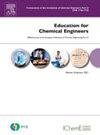利用过程模拟器加强第四学期化工专业学生对换热器设计的学习
IF 2.3
2区 教育学
Q1 EDUCATION, SCIENTIFIC DISCIPLINES
引用次数: 0
摘要
本研究探讨了蒙特雷理工学院(ITESM)墨西哥校区第四学期化学工程专业学生对阿斯彭交换器设计和评级(EDR)软件使用情况的看法。该大学的Tec21教育模式要求学生解决教授和外部培训合作伙伴提出的现实挑战。在本研究中,化学工程第四学期的学生被要求在两个连续的学习模块中为胺吸收系统设计一个管壳式换热器。Block I专注于传热系统,将理论和实践知识与手工和Excel计算相结合。在第2块中,学生们使用Aspen Plus和Aspen HYSYS进行快捷计算,使用Aspen EDR进行严格计算,以验证第1块中的建议。在第2块结束时,研究指标显示,学生们重视培训伙伴的参与和现实世界的挑战,认为这些对他们的学术经历有重大贡献。他们强调了在学术生涯早期学习模拟软件的重要性,因为它可以验证人工计算并产生最佳设计。他们认为这项挑战能激发智力,并认为它能增强横向能力,如批判性思维、团队合作和适应力。本文章由计算机程序翻译,如有差异,请以英文原文为准。
Using a process simulator to enhance the learning of heat exchanger design in fourth-semester chemical engineering students
This study explored the perceptions of fourth-semester Chemical Engineering students at Tecnologico de Monterrey (ITESM), State of Mexico Campus, regarding their use of Aspen Exchanger Design and Rating (EDR) software. The university’s Tec21 Educational Model requires students to resolve real-world challenges posed by professors and external training partners. In the study, students in the fourth semester of Chemical Engineering were required to design a shell and tube heat exchanger for an amine absorption system in two consecutive learning blocks. Block I focused on heat transfer systems, combining theoretical and practical knowledge with manual and Excel calculations. In Block II, students used Aspen Plus and Aspen HYSYS for shortcut calculations and Aspen EDR for rigorous calculations to validate their proposals in Block I. At the end of Block II, study indicators revealed that the students valued the engagement of training partners and real-world challenges, considering these to have significantly contributed to their academic experience. They emphasized the importance of learning simulation software early in their academic careers, as it validates manual calculations and produces optimal designs. They described the challenge as intellectually stimulating and believed it strengthened transversal competencies such as critical thinking, teamwork, and resilience.
求助全文
通过发布文献求助,成功后即可免费获取论文全文。
去求助
来源期刊

Education for Chemical Engineers
Multiple-
CiteScore
8.80
自引率
17.90%
发文量
30
审稿时长
31 days
期刊介绍:
Education for Chemical Engineers was launched in 2006 with a remit to publisheducation research papers, resource reviews and teaching and learning notes. ECE is targeted at chemical engineering academics and educators, discussing the ongoingchanges and development in chemical engineering education. This international title publishes papers from around the world, creating a global network of chemical engineering academics. Papers demonstrating how educational research results can be applied to chemical engineering education are particularly welcome, as are the accounts of research work that brings new perspectives to established principles, highlighting unsolved problems or indicating direction for future research relevant to chemical engineering education. Core topic areas: -Assessment- Accreditation- Curriculum development and transformation- Design- Diversity- Distance education-- E-learning Entrepreneurship programs- Industry-academic linkages- Benchmarking- Lifelong learning- Multidisciplinary programs- Outreach from kindergarten to high school programs- Student recruitment and retention and transition programs- New technology- Problem-based learning- Social responsibility and professionalism- Teamwork- Web-based learning
 求助内容:
求助内容: 应助结果提醒方式:
应助结果提醒方式:


